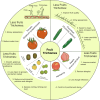The role, regulation and application of plant fruit trichomes
- PMID: 40775671
- PMCID: PMC12333248
- DOI: 10.1186/s43897-025-00167-x
The role, regulation and application of plant fruit trichomes
Abstract
Trichomes, hair-like specialized epidermal structures on the surface of most plant organs, play key roles in plant defense against herbivores, reducing water loss, and shielding plants from UV radiation, among other functions. Controlling trichome development and the biosynthesis of trichome-derived specialized metabolites is a common defensive strategy adopted by plants to protect themselves from environmental stresses. However, trichomes exhibit distinctive functions in different plant tissues. Fruits, being the most economically valuable organs of many horticultural plants, often have trichomes on their surface. Nevertheless, there is a notable lack of research on the regulation and function of fruit trichomes, in comparison to the extensive studies conducted on trichomes in other plant tissues. Further investigation is needed to elucidate the specific functions of fruit trichomes. The regulation of plant trichome development and the multiple roles of trichomes represent a dynamic area of plant biology with significant implications for agriculture and biotechnology. This review aims to enhance the understanding of the functions, regulatory mechanisms, and applications of fruit trichomes, emphasizing their importance in advancing agricultural sustainability and productivity.
Keywords: Fruit trichome; Post-harvest; Transcription factor; Water loss.
© 2025. The Author(s).
Conflict of interest statement
Declarations. Ethics approval and consent to participate: Not applicable. Consent for publication: Not applicable. Competing interests: The authors declare that they have no competing interests. Prof. Jocelyn K. C. Rose is an Associate Editor of Molecular Horticulture. He had no role in the review and decision of this manuscript.
Figures


References
-
- Baranowska-Wójcik E, Szwajgier D. Characteristics and pro-health properties of mini kiwi (Actinidia arguta). Hortic Environ Biotechnol. 2019;60:217–25.
-
- Berhin A, Nawrath C, Hachez C. Subtle interplay between trichome development and cuticle formation in plants. New Phytol. 2022;233:2036–46. - PubMed
-
- Botton A, Vegro M, De Franceschi F, Ramina A, Gemignani C, Marcer G, et al. Different expression of Pp-LTP1 and accumulation of Pru p 3 in fruits of two Prunus persica L. Batsch Genotypes. Plant Sci. 2006;171:106–13.
Publication types
Grants and funding
LinkOut - more resources
Full Text Sources
